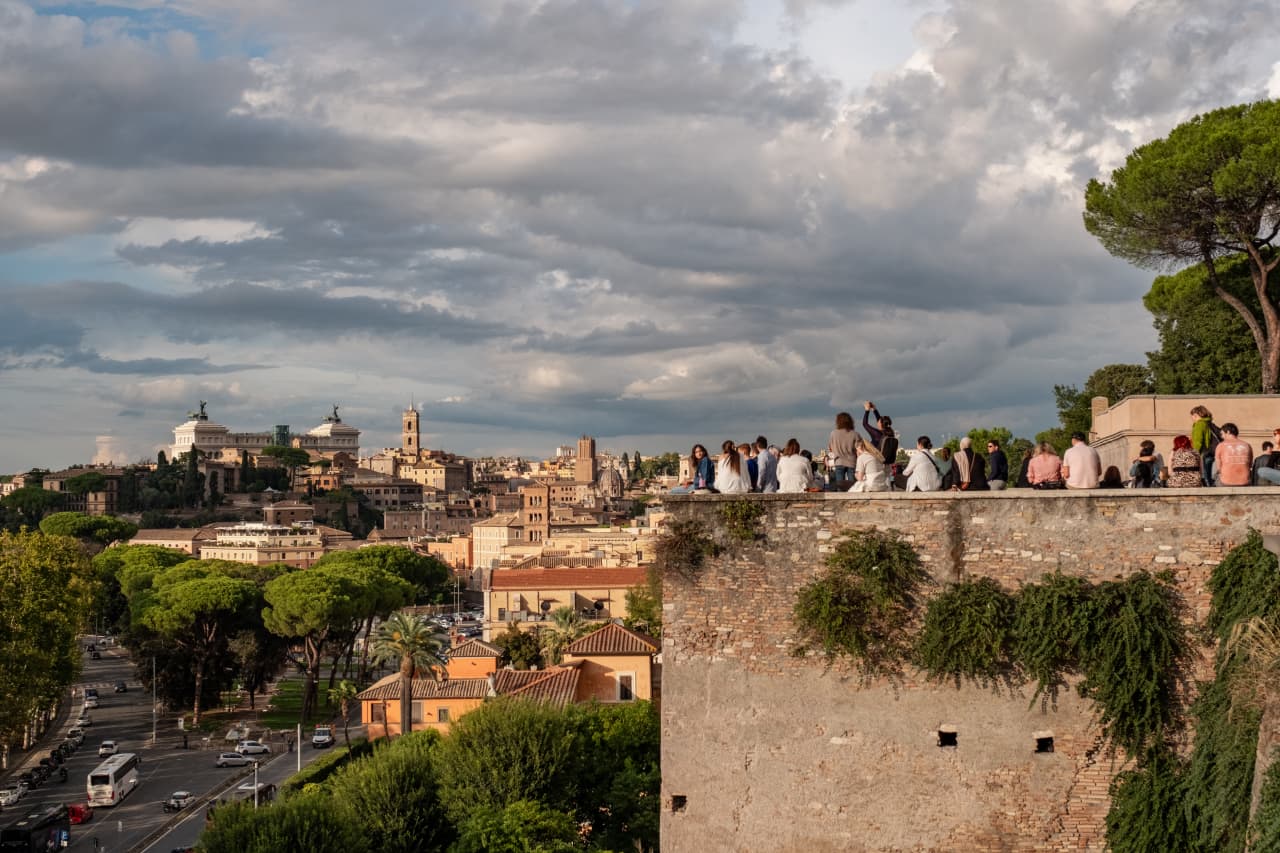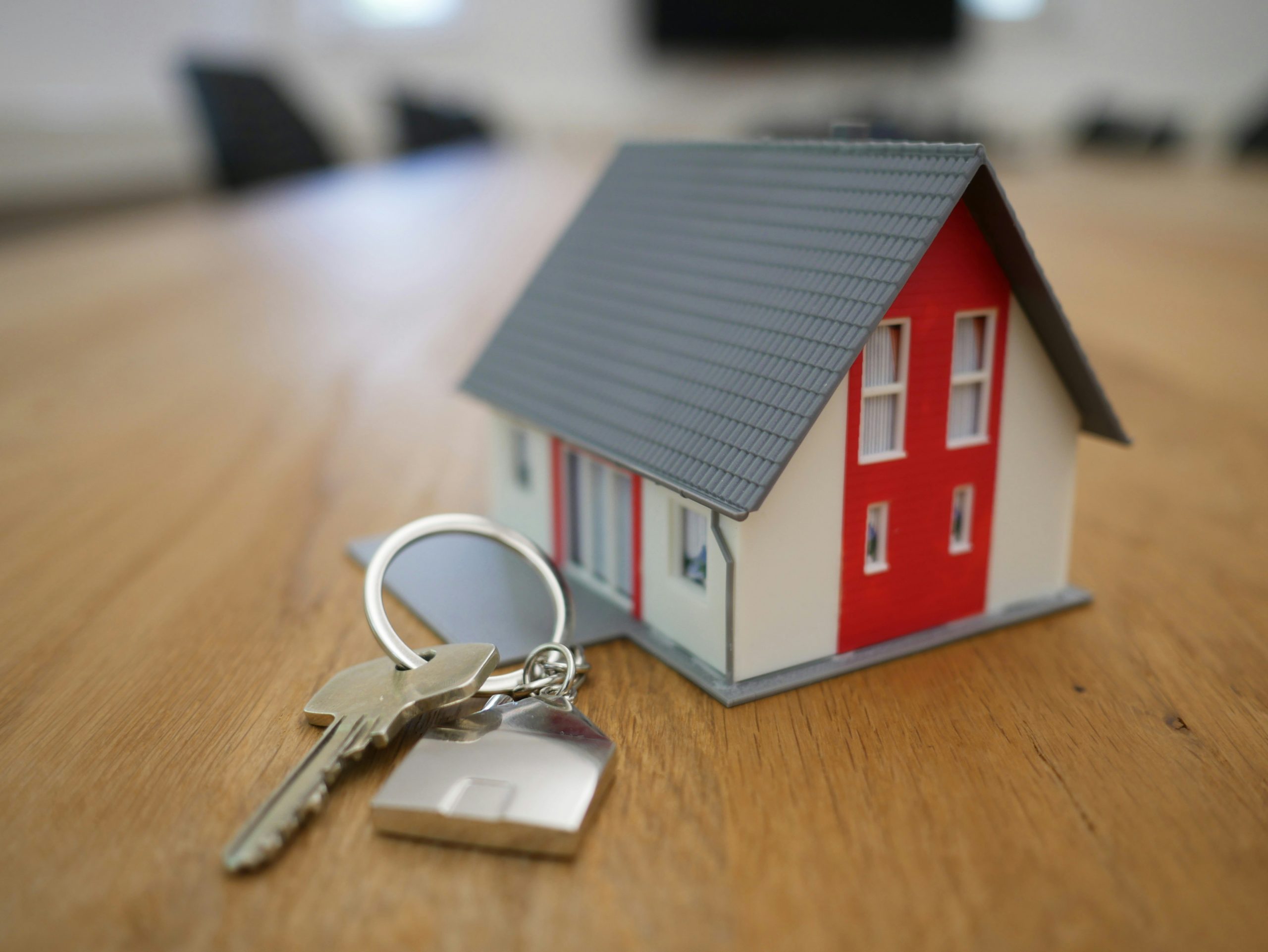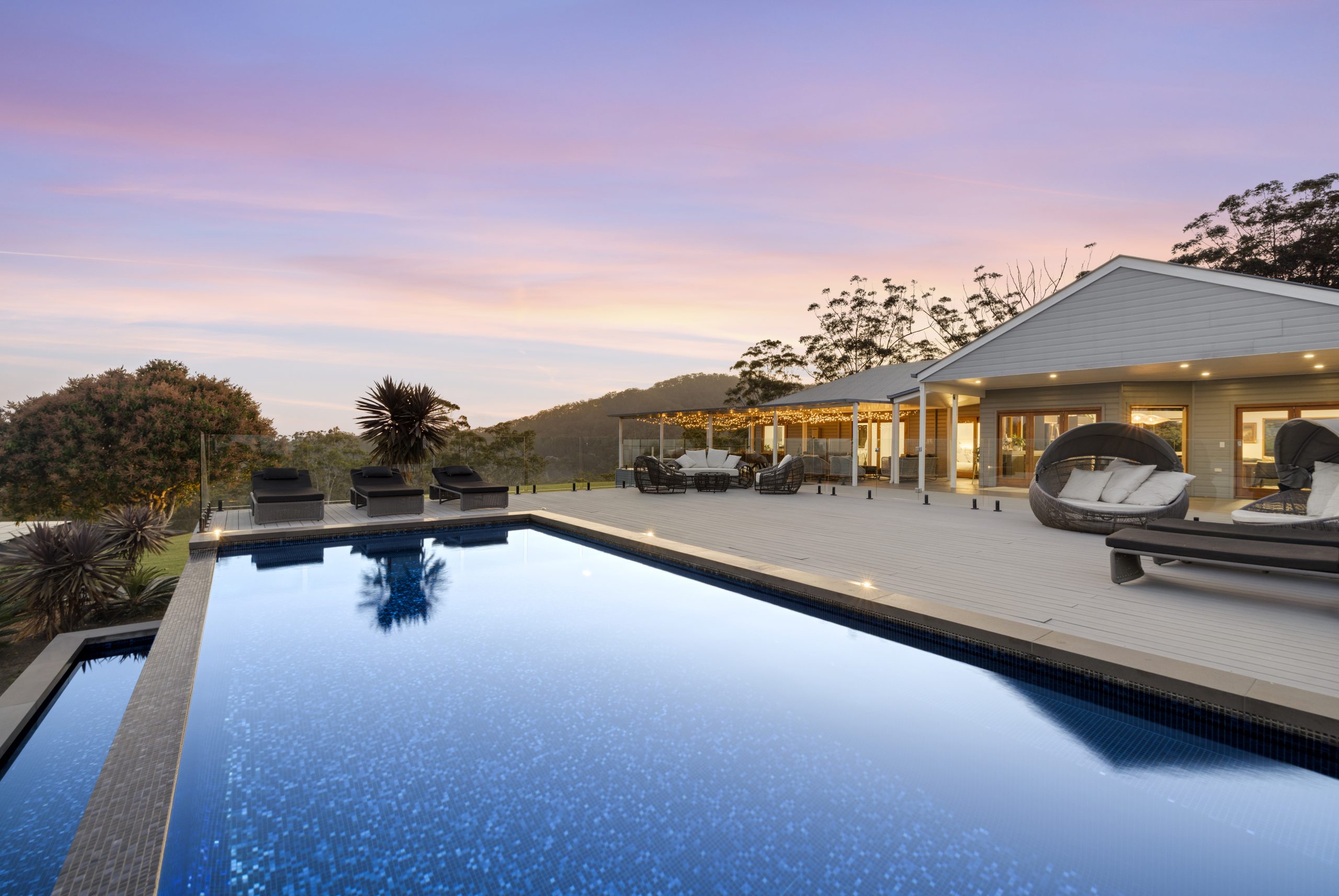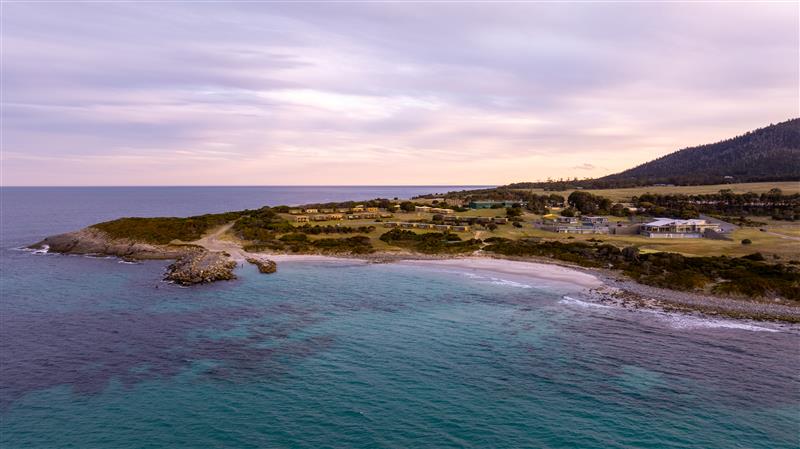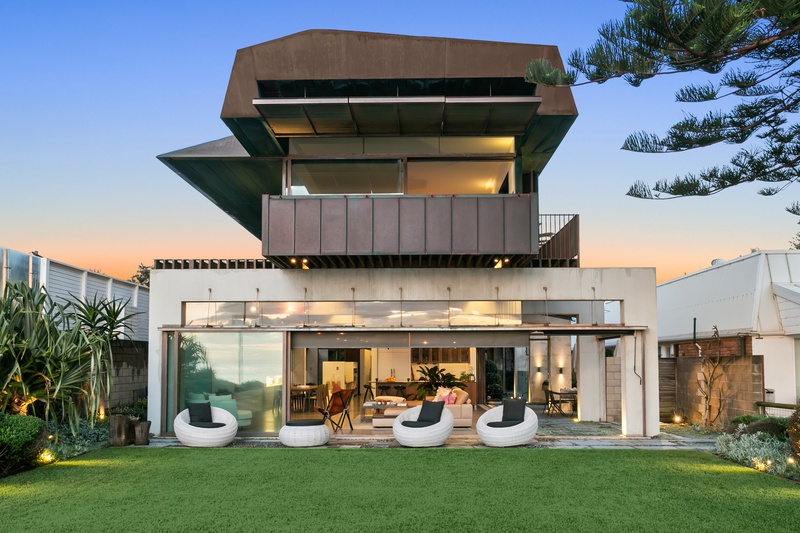Even in Its Priciest Neighbourhoods, Buying in Rome Remains a Bargain
Compared with other luxury housing markets in Europe, buyers get more bang for their buck in Italy’s capital
Gianluca and Selene Santilli have all of Rome at their feet.
Their four-storey penthouse apartment in an early 20th-century villa sits atop a hill in the Italian capital’s Parioli district. With 360-degree views from sitting rooms and outdoor areas, the property provides glimpses of the dome of St. Peter’s Basilica, residential Parioli’s towering pine trees and the winding course of the Tiber River.
The 4,010-square-foot home has free-standing pavilion-like spaces that suggest an urban compound more than an individual apartment. Now, after nearly two decades in the custom-designed space, the couple have listed the four-bedroom unit with Italy/Sotheby’s International Realty. It has an asking price of $6.1 million.
A similar level of luxury in Milan, Italy’s financial and fashion capital, would cost a lot more, says Gianluca, a 67-year-old attorney. “Rome is cheap,” he says, of both the homes for sale and for rent.
Gianluca and Selene, a 64-year-old office manager, priced their home at just under $1,500 a square foot. In Milan, by comparison, a smaller three-bedroom, 2,750-square-foot unit in a decade-old high-rise, with lavish views and similarly upscale fittings, is listed for $6.445 million, or about $2,350 a square foot.
Roman-style luxury was once associated with the gargantuan villas of ancient emperors and the frescoed palaces of Baroque-era princes, but these days it conjures up another phrase: a bargain.
Affordable Luxury
Rome’s average home prices, as of August, were about $350 a square foot—less than Italy’s Florence and Bologna, and around a third less than Milan, according to Immobiliare.it, a real-estate website.
Prices in Rome peaked in 2007, and the city has been slow to encourage new development and investment, says Antonio Martino, the Milan-based real-estate advisory leader for PwC Italy. In Milan, on the other hand, an increase in supply has been outpaced by a greater increase in demand, he says.
A one-bedroom apartment in Rome is far more affordable than the average for major European cities, coming in below Barcelona, Amsterdam and Vienna, according to an affordability index compiled by Savills, the international real-estate company, which analyzed apartments outside of the historic city centres.
An average-earning Roman might need only four years’ salary to buy the apartment, while a Parisian would likely need more than twice that, according to Savills.
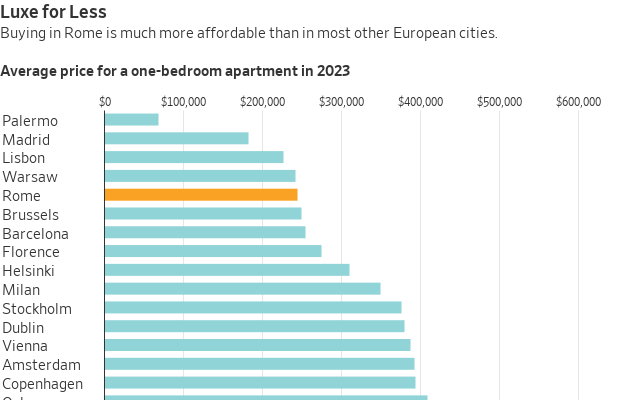
Rome’s luxury sector is showing new signs of life, outpacing the rest of the market, says Danilo Orlando, managing director of Savills Residential Italy. Comparing 2023 sales of homes over $1.1 million with prepandemic 2019 levels, he says, prices in Rome have increased 4% while the number of luxury-level transactions has risen 3.6%. Overall real-estate transactions were up 3% in the second quarter of this year, compared with a year earlier, says PwC’s Martino.
Orlando says that residential luxury sales in Rome are traditionally concentrated in three nearby areas that are the city’s most expensive: The Centro Storico, or the historic center, is where centuries-old palaces are often broken up into lavish multi-bedroom apartments. Parioli is a hilly district known for its Midcentury Modern flare. And a short walk away is Trieste, which has clusters of early 20th-century apartment buildings that vie in splendour with their Baroque counterparts down in the centre.
Centro Storico and Trieste
Centro Storico is by far the most expensive, says Orlando, with average prices in the premium sector reaching $1,493 a square foot in 2023. Luxury units in Parioli average about $950 a square foot, while those in Trieste are about $900 a square foot.
Tourists may flock to Centro Storico’s celebrated sites, like the Trevi Fountain, or make their way through the Villa Borghese, a massive landscaped garden that serves as a green space for both Parioli and Trieste. But they are likely to miss the three districts’ prime residential areas, which can seem discreet, if not outright hidden.
Centro Storico’s Via Giulia, running just east of the Tiber, and Via Margutta, tucked under Piazza del Popolo, are hard-to-find streets if you’re not looking for them. Via Giulia was once the address of choice for Roman nobles, and it can still lay claim to being one of the city’s most prestigious streets. A two-bedroom Via Giulia triplex, located in a building dating back to the 16th century and outfitted with vintage coffered ceilings, is listed with Italy/Sotheby’s, with an asking price of $2 million.
The centrepiece of Trieste is the Coppedè quarter, a neighbourhood of towering 1910s and ’20s apartment buildings, decorated with Moorish arches and ghoulish gargoyles, and built around a storybook-like frog fountain. Conceived by an eccentric Florentine-born architect named Gino Coppedè, the quarter combines Art Nouveau elements with a range of historical styles.
Exclusive RE/Christie’s International Real Estate has a well-maintained, four-bedroom Coppedè listing for $3.56 million. Original details in the 3,770-square-foot home include stained-glass windows, mosaic tile floors and painted ceilings.
Parioli and Pinciano
Parioli, with its many steep streets, is a bit more remote, while Trieste is flatter and more urban. For many luxury-minded Romans, a fine compromise is Pinciano, a neighborhood beneath the heart of Parioli that is as rarefied as its hilly neighbour but as accessible as Trieste.
In 2007, Dr. Claudio Giorlandino, a Roman gynaecologist, created a sprawling family home in a Pinciano building that had been commissioned just before World War I, he says, by a member of the House of Savoy, then the Kingdom of Italy’s ruling family. Designed by a noted Venetian-Jewish architect and decorated with marble recovered from a Palladian villa in northeast Italy, the building has a small number of units, with Giorlandino’s 6,200-square-foot apartment taking up a whole floor.
“I love the elegance and the extremely refined, aristocratic atmosphere,” Giorlandino, now 70, says of his neighbourhood, which borders the Villa Borghese.
Now that two of his three children are grown and living on their own, he has listed the home with Exclusive RE/Christie’s for $6.89 million.
Rome’s three most expensive districts can seem like a self-contained world, with residents moving around between them. Giorlandino, who relocated from the Centro Storico to Pinciano, is now thinking about moving back to the historic centre. The Santillis, who moved to Parioli from Trieste, are considering looking for a more compact rental still in Parioli, which they say feels insulated from the Italian capital’s notorious traffic.
“We have the historic centre nearby, but we are not in the chaos of the centre,” says Gianluca Santilli, adding that he considers “the jewels” of his unique penthouse to be the home’s three parking spaces.
Vatican views
American buyers, traditionally drawn to the Centro Storico, are also open to Parioli and to the Aventine Hill, a very steep, purely residential area on the edge of the historic centre, says Diletta Giorgolo, head of residential at Italy/Sotheby’s.
Known for its jaw-dropping views of the Vatican and for its sedate, almost suburban quality, the Aventino, as Italians call it, may be Rome’s most elusive address. Premium listings rarely come up for sale.
Lionard Luxury Real Estate currently has a ¼-acre Aventino compound, with an early 20th-century 10,800-square-foot villa, listed for $22.2 million.
Mother-daughter apartments
A new Centro Storico development proved too good to pass up for Delphine Surel-Chang, a U.S.-born student studying business in Rome, and her French mother, former actress and investor Francoise Surel, who will also relocate.
The two are putting the finishing touches on their new homes in the Palazzo Raggi, where 21st-century details are being installed in a renovated 18th-century palazzo situated between the Trevi Fountain, Piazza Navona and the Pantheon. This summer, Surel purchased a 1,460-square-foot, two-bedroom apartment for herself, and Surel-Chang says her parents helped her buy a 645-square-feet one-bedroom. The units cost $1.88 million and about $944,000, respectively. They are set to move in later this year.
Surel-Chang, 20, says she loves how the project’s contemporary elements—which she and her mother, 60, are augmenting with kitchens and bathrooms from Italy’s sleek Boffi brand—are housed in a classical setting. And she appreciates amenities like a concierge and home automation, allowing residents to control temperature, lighting and appliances via app.
She was able to customise her unit’s interiors, she says, by drawing inspiration from her two favorite local hotels, the Bulgari Hotel Roma and Six Senses Rome. She plans to furnish the unit, where she says they will stay for at least three years, with Italian Midcentury Modern pieces.
The duo bought the apartments—which are a five-minute walk from Via Condotti, Rome’s premier shopping street—for between $1,200 and $1,500 a square foot, using Italy/Sotheby’s, which also helped develop the project.
The apartments can seem like a bargain compared with similarly situated units in other major cities. For instance, a two-bedroom, 2,025-square-foot apartment in London’s Mayfair district—a five-minute walk from Bond Street, Via Condotti’s U.K. shopping district equivalent—is asking nearly $10,000 a square foot.
Affordability played a part in their choice of the Eternal City, says Surel-Chang. They considered relocating to Paris, she says, but soon realised that “for the price of an apartment in Paris, we can afford two in Rome.”
 Copyright 2020, Dow Jones & Company, Inc. All Rights Reserved Worldwide. LEARN MORE
Copyright 2020, Dow Jones & Company, Inc. All Rights Reserved Worldwide. LEARN MORE
Pure Amazon has begun journeys deep into Peru’s Pacaya-Samiria National Reserve, combining contemporary design, Indigenous craftsmanship and intimate wildlife encounters in one of the richest ecosystems on Earth.
Australia’s housing market defies forecasts as prices surge past pandemic-era benchmarks.
Australia’s housing market defies forecasts as prices surge past pandemic-era benchmarks.
Australian house prices are surging again, delivering double-digit annual growth months ahead of schedule.
Nationally, the median house price climbed 1.1 per cent in October to $940,000, lifting annual growth to 10.6 per cent, the first double-digit increase since the 2021–22 property boom.
Market Resilience Surprises Analysts
The acceleration comes earlier than expected, according to Ray White Group Chief Economist Nerida Conisbee, who says the milestone was originally forecast for the end of the year.
“Stronger-than-expected October gains and continued tight supply across most markets have pushed growth ahead of schedule,” Conisbee said. “This shows how resilient demand has remained through spring.”
Perth (+14.8 per cent), Brisbane (+12.5 per cent) and Adelaide (+10.8 per cent) continue to lead the charge among capital cities, while Sydney (+8.6 per cent) and Melbourne (+6.5 per cent) show steady, consistent increases.
Regional Markets Extend Their Lead
Beyond the capitals, regional Australia is powering ahead, particularly in the resource states.
Regional Western Australia jumped 16.4 per cent year-on-year, and regional Queensland followed close behind at 14.5 per cent, as population growth and affordability continue to drive demand.
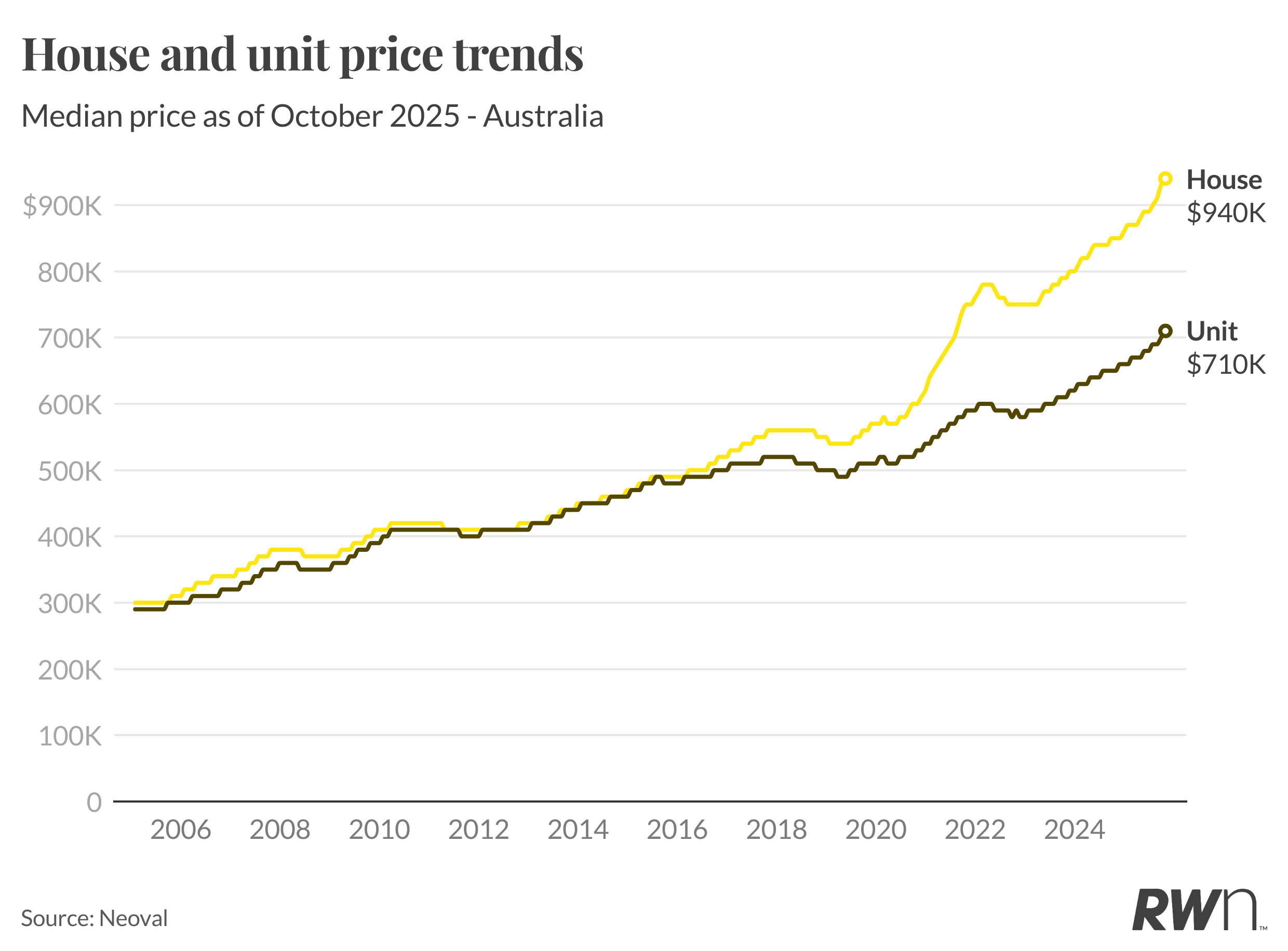
Units Outperform Houses
Unit prices rose even more sharply in October, up 1.4 per cent to $710,000, marking 9.2 per cent annual growth. Conisbee said affordability pressures, new first home buyer incentives, and a lack of available stock are pushing more buyers into the apartment market.
“Units are now seeing stronger monthly gains than houses, reflecting both affordability constraints and renewed first-home-buyer activity,” she said.
The biggest monthly jumps were in Perth (+1.6 per cent), Adelaide (+1.5 per cent), and Brisbane (+1.4 per cent). Melbourne’s unit market also firmed, up 1.6 per cent, as buyers returned to lower price brackets.
Spring Demand Defies Higher Listings
Despite an influx of spring listings, new stock has failed to match the intensity of buyer demand. Nationally, house prices have now risen every month since February, and unit prices every month since March.
“The pace of growth shows demand hasn’t been dampened by higher supply,” Conisbee said.
Outlook: Steady Growth Into 2026
The data comes as the Reserve Bank prepares for its Melbourne Cup Day meeting, where rates are expected to remain on hold at 3.6 per cent.
With inflation easing only gradually and unemployment sitting around 4.5 per cent, analysts expect monetary policy to stay steady for now.
Ray White’s forecast suggests 2025 will close with high single- to low double-digit annual growth nationally, with smaller capitals and regional areas tipped to outperform well into 2026.
From Italy’s $93,000-a-night villas to a $20,000 Bowral château, a new global ranking showcases the priciest Airbnbs available in 2026.
A luxury lifestyle might cost more than it used to, but how does it compare with cities around the world?









